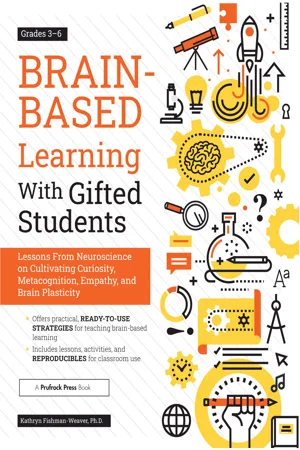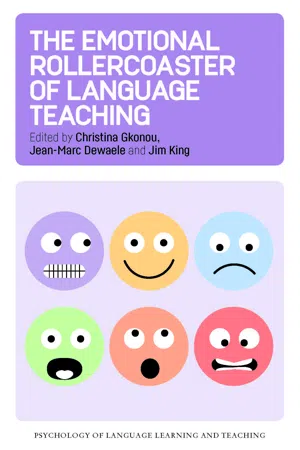Business
Emotional Regulation
Emotional regulation refers to the ability to manage and control one's emotions in a constructive manner. In a business setting, emotional regulation is important for maintaining professionalism, managing stress, and fostering positive relationships with colleagues and clients. It involves recognizing and understanding one's emotions, as well as employing strategies to regulate and express them appropriately.
Written by Perlego with AI-assistance
Related key terms
8 Key excerpts on "Emotional Regulation"
- eBook - ePub
Translation and Emotion
A Psychological Perspective
- Séverine Hubscher-Davidson(Author)
- 2017(Publication Date)
- Routledge(Publisher)
3 Emotion RegulationEmotion is the foundation on which every aspect of human behaviour ultimately rests. All our intentions and purposes are coloured by it, especially, our attempts to control and influence others. —Derek LayderBroadly speaking, this chapter deals with the construct of emotion regulation, a process by which individuals modify their emotional experiences in order to produce appropriate responses in particular contexts. The chapter defines and reviews the construct, and demonstrates how people differ in the ways they regulate their emotions and how these emotion regulation processes affect their lives, including consequences for their social and psychological functioning. The use and understanding of the construct within trait EI theory are then outlined, and examples of its application in practice are provided. Subsequently, the chapter addresses how the choice and use of different emotion regulation strategies differ between translators and how these individual differences have implications for their work. The chapter attempts to provide an answer to the following question: Could some forms of emotion regulation be more efficient or useful than others for translation practice? The final section of the chapter reviews evidence from the case study to inform the discussion.Part 1: Emotion Regulation and Psychology
Emotion Regulation: A Definition
The field of emotion regulation has known exceptional growth over the last 10 to 15 years, and the topic is one of the fastest-growing areas within Psychology (Gross 2007, 2013). The development of new methods to examine emotion regulation processes, alongside a wider range of populations under study, have enhanced our understanding of the psychological and behavioural processes by which people influence their emotions and those of other people. However, as theoretical discussions and empirical studies related to emotion regulation cut across disciplinary boundaries (Gross 2007, xi), it can be somewhat difficult to obtain a comprehensive understanding of what emotion regulation actually is. - eBook - ePub
Cognition and Emotion
Reviews of Current Research and Theories
- Jan de Houwer, Dirk Hermans, Jan de Houwer, Dirk Hermans(Authors)
- 2010(Publication Date)
- Psychology Press(Publisher)
The present article provides an integrative review of contemporary research on the psychology of emotion regulation. The relevant literature is too large to be covered exhaustively. Consequently, the present article gives priority to ideas and findings with broad implications for the psychology of emotion regulation. Because the development and disorders of emotion regulation have been reviewed elsewhere (Kring & Werner, 2004; Skinner & Zimmer-Gembeck, 2007; Southam-Gerow & Kendall, 2002; Taylor & Liberzon, 2007), the present article concentrates on emotion regulation among healthy adults. In the following paragraphs, I first consider more closely what emotion regulation is and how it relates to other forms of emotion processing. Next, I discuss several approaches to classifying strategies of emotion regulation and review empirical research on emotion-regulation strategies. Finally, I summarise the main conclusions of the present article and suggest avenues for future research on emotion regulation.WHAT IS EMOTION REGULATION?
In everyday life, people are continually exposed to potentially emotion-arousing stimuli, ranging from internal sensations like an upset stomach to external events such as juicy gossip about a colleague or music played in supermarkets. From the fact that these kinds of stimuli only occasionally trigger full-blown emotions, one could infer that people engage in some form of emotion regulation almost all of the time (Davidson, 1998). But emotion regulation may also become manifested in more overt ways. For instance, there are reliable observations that people may rapidly shift their attention away from threatening stimuli (Langens & Mörth, 2003), that people may overcome traumatic experiences by writing about them (Pennebaker & Chung, 2007), and that people may choose to hit a pillow instead of lashing out at the true cause of their anger (Bushman, Baumeister, & Phillips, 2001).In each of the aforementioned cases, people resist being carried away or ‘‘hijacked’’ (Goleman, 1995) by the immediate emotional impact of the situation. Emotion regulation can thus be defined as the set of processes whereby people seek to redirect the spontaneous flow of their emotions. Some approaches have also considered emotion regulation by the external environment. For instance, developmental research indicates that caregivers may play a key role in regulating children’s emotional states (SouthamGerow & Kandell, 2002) and environmental research has shown that natural settings can promote more rapid recovery from stress than urban settings (Van den Berg, Hartig, & Staats, 2007). Emotion regulation by forces outside the self is clearly important. Nevertheless, following the predominant focus of the literature (Gross, 2007), the present article concentrates on the self-regulation of emotion. - Laura Petitta, Charmine E. J. Härtel, Neal M. Ashkanasy, Wilfred Zerbe(Authors)
- 2018(Publication Date)
- Emerald Publishing Limited(Publisher)
Niven, Totterdell, & Holman, 2009 ; Niven, Totterdell, Stride, & Holman, 2011 ) as well as the attenuation of negative affect in the presence of others (Coan, 2011 ). More recently, Zaki and Williams (2013) define the interpersonal regulation as episodes (1) occurring in the context of a live social interaction, and (2) representing the pursuit of a regulatory goal. This definition integrates the existing work on the domain and underlines the importance of social sharing of emotions as integral to interpersonal emotion regulation. This chapter proceeds with this definition. While the previous research on interpersonal emotion regulation has covered customer facing, service, health or sales organizations (Brown, Westbrook, & Challagalla, 2005 ; Hadley, 2014 ; McCance, Nye, Wang, Jones, & Chiu, 2013 ), emotionally charged and financial workplaces such as investment banks where high stakes are set within an emotionally charged environment have yet to be explored. In their work on financial traders, Fenton-O’Creevy, Soane, Nicholson, and Willman (2011) identified the presence and relevance of emotions in trading (Vohra & Fenton-O’Creevy, 2011 ), however, focused only on intrapersonal emotion regulation strategies. In this chapter, drawing on the previous research on emotions in trading (Fenton-O’Creevy et al., 2011 ; Vohra & Fenton-O’Creevy, 2011 ), social sharing of emotions (Rimé, Finkenauer, Luminet, Zech, & Philippot, 1998 ; Rimé, Mesquita, Philippot, & Boca, 1991 ) as well as interpersonal emotion regulation (Zaki & Williams, 2013 ), the ways in which interpersonal emotion regulation can take place in the fast paced, high stress environment of investment banks are identified. In doing so, the definition of interpersonal emotion regulation put forth by Zaki and Williams (2013) is extended and it is argued that while the pursuit of a regulatory goal is paramount, the benefits of interpersonal regulation may be achieved even in the absence of live social interaction, as long as labeling of the affective state takes place. In other words, response-independent intrinsic emotion regulation (Zaki & Williams, 2013 ) can be achieved, for example, with writing things down for self-reflection, as in doing so the individual will engage in labeling of affective state and the sources of those states. Such labeling can reduce ambiguity of affective states and facilitate coping (Kircanski, Lieberman, & Craske, 2012 ; Lieberman, Inagaki, Tabibnia, & Crockett, 2011 ), especially when accompanied by assessment of the causes underlying an affective state (Kross, Ayduk, & Mischel, 2005 ; Pennebaker, 1997 ). This is consistent with the work on social sharing of an emotional event (Rimé et al., 1991, 1998 ) in written form (McCance et al., 2013 ) and in attenuated forms using letters and diaries (Rimé, 2009- eBook - ePub
Christianity and Developmental Psychopathology
Foundations and Approaches
- Kelly S. Flanagan, Sarah E. Hall(Authors)
- 2014(Publication Date)
- IVP Academic(Publisher)
3Emotion Regulation
Sarah E. Hall For everything God created is good, and nothing is to be rejected if it is received with thanksgiving, because it is consecrated by the word of God and prayer. 1 Timothy 4:4-5We are created by God, in his image, including our thoughts, feelings and capacity for action. Sometimes Christians view emotions as primarily negative and sinful, interfering with our ability to serve God, such as when we become angry or anxious. However, both Scripture and psychological research support a view of emotions as having the potential to either enhance or interfere with healthy development, including spirituality. This chapter will explore the concept of emotion regulation from a developmental psychopathology framework, covering definitional issues, normative development, factors that affect and are affected by the development of emotion regulation, and the three integrative themes explored through this volume.Definition and Study of Emotion Regulation
Emotion regulation is the process of changing or maintaining the experience and/or expression of emotion in order to achieve one’s goals (Eisenberg & Spinrad, 2004; Thompson, 1994). Often when we think about individuals who are affectively well regulated, we think of those who can cope effectively with sadness or anger. However, emotion regulation is more complex than just the reduction of negative emotions. It includes reducing, maintaining or enhancing emotions; internal experiences as well as behavioral responses; and both positive and negative emotions (Cole, Michel & Teti, 1994). Emotion regulation occurs in the case of both a child who resists hitting a classmate when he is angry and an adolescent who smiles and congratulates the competitor who has just defeated her in an important athletic event.How do we define good, skillful or healthy emotion regulation? Several aspects of emotion, behavior and development should be considered. First, skillful emotion regulation is effective. Children (and adults) who are emotionally well regulated are able to both monitor and alter their emotional states effectively (i.e., their attempts to sustain or change emotions are successful). Second, skillful emotion regulation is adaptive. The techniques for emotion regulation—and their outcome—must result in behavior that is appropriate in a given context. A kindergartener whose school anxiety is only alleviated by clinging to his mother is not adapting well to the classroom setting and the need to separate from her. Third, skillful emotion regulation is flexible (Sroufe, 1995). Because different contexts demand different responses, a child must be able to assess the situation and self-regulate in a manner that is contextually appropriate. For example, progressive muscle relaxation might be an appropriate anxiety-reducing strategy when a child is in her bedroom at home but not when she is taking a test at school. In order to support that flexibility, a range of effective regulatory strategies must be available to the individual. Furthermore, different techniques are likely to be effective for regulating different emotions; an adolescent with strong emotion-regulation skills might use self-talk to regulate his anxiety most effectively but find deep breathing more useful when he is extremely angry. Finally, skillful emotion regulation supports the achievement of both short- and long-term developmental goals. Healthy emotional functioning involves the ability to achieve one’s goals in the face of emotion and to utilize emotion to facilitate movement toward a goal (cf. functional theories of emotion which state that anger, for example, motivates us to overcome obstacles that block goals; Eisenberg & Spinrad, 2004; Frijda, 1987). In addition, children’s emotion regulation abilities are judged according to how they affect movement toward or away from common parental and societal goals for children, such as the ability to form close friendships and to succeed in school and work environments, regardless of whether a child or adolescence shares these goals. In this way, a multisystemic view is necessary to fully assess emotion regulation: in what way do children’s emotions and related behavior affect their own sense of well-being and - eBook - ePub
Emotions and the Family
for Better Or for Worse
- Elaine A. Blechman, Alan M. Delamater(Authors)
- 2013(Publication Date)
- Routledge(Publisher)
Chapter 4 The Development of Emotion Regulation: Effects on Emotional State and ExpressionCarolyn Saarnl Sonoma State University, CaliforniaMichael Crowley University of OregonEmotion regulation may be defined as behavior aimed at changing feelings in a desired direction. That the change is in a desired direction is inferred from the term regulation, which implies purposeful action of a regulator or governing mechanism. Behavior, in this context, should be broadly defined to include not only easily observed actions but also physiological changes and cognitions. We use the term "feelings" here to refer to a similarly broad class of responses: Feelings may be either physiological states or the subjective awareness and experience of emotion that is influenced by both physiological response and personal interpretation (Schacter & Singer, 1962).The process of changing feelings may include replacing one emotional state with another or altering the intensity of a feeling. An example of the former is when we feel rejected and deeply hurt we change our vulnerable feeling state into a less vulnerable one by shifting our attention to the "bad" intentions of the rejector and replace our former emotional state of hurt with anger—an emotion that reduces feelings of vulnerability. An example of the second sort of change, altering the intensity of emotional state, is when we experience a loss and attempt to reduce the intensity of grief associated with the loss through reappraisal of the situation; for example, the death of an ill relative engenders sadness and loss, yet we may try to focus on the relief of suffering that death brought to the deceased so as to ameliorate our own sadness.Regulation of emotional state begins with inborn, homeostatic mechanisms or reflexes; thus, it can be considered to be a biological drive toward adaptation to environmental change. Emotion regulation may also occur through effortful behaviors, including changes in cognition, which may function as attempts at adaptation. This latter sort of adaptation is most commonly employed in later childhood and adulthood as a way of coping with negative feelings or stress. Because adaptation is essential to survival and growth (and an increasing body of research links successful coping with emotional and physical health), processes of emotion regulation deserve serious attention. As developmental psychologists we are interested in examining how the process of emotion regulation changes through growth and development of the individual and in exploring the factors that influence such change. - eBook - ePub
Brain-Based Learning With Gifted Students
Lessons From Neuroscience on Cultivating Curiosity, Metacognition, Empathy, and Brain Plasticity: Grades 3-6
- Kathryn Fishman-Weaver(Author)
- 2021(Publication Date)
- Routledge(Publisher)
Emotional Regulation helps students (and teachers) better understand and respond to their complex feelings. As people get older, they tend to become more adept at Emotional Regulation. One gifted student described it to me in this way: “It’s learning strategies to give me some control over my emotions rather than always feeling like my emotions are controlling me.”KEY CONCEPTEmotional Regulation: The process by which one recognizes, experiences, and responds to feelings.- Explicit Emotional Regulation: A conscious effort to use strategies to respond to emotions.
- Implicit Emotional Regulation: Automatic processes in response to emotions.
Emotions interact and influence each other (Okon-Singer et al., 2015). For example, when a person is deeply angry, they are less likely to experience joy. However, by recognizing, naming, and processing that anger, they may be able to both regulate it and create space for additional emotions such as joy. Likewise, when a person is persisting toward a goal, sometimes their feelings of pride or joy are enhanced by earlier experiences with frustration or sadness that occurred as they strove for this goal. Teachers can help students with strategies to improve their explicit Emotional Regulation skills. This starts with five basic premises shown in Figure 12 .When it comes to emotion, neuroscience supports what teachers have long suspected: How students feel affects how they learn. Emotion and cognition are not separate processes. Instead, the complex interplay of emotional processing and cognitive processing reveals a coordinated response across brain structures with consequences for attention, working memory, and executive functioning (Okon-Singer et al., 2015). Neuroscientists are continuing to learn more about how and where emotion happens in the brain.The Neuroanatomy of Emotions: A Look at the Limbic System
This unit focuses on key structures of the limbic system. Although this is not a comprehensive overview of all brain structures involved in emotional processing, it is a good starting place as teachers and students build a working knowledge of the neuroscience of Emotional Regulation. To extend your study on the neuroanatomy of emotions, see the extension resources. - eBook - ePub
- Christina Gkonou, Jean-Marc Dewaele, Jim King(Authors)
- 2020(Publication Date)
- Multilingual Matters(Publisher)
et al., 2015). In light of this, emotions should not only be considered as intrapersonal phenomena, but also as being continually shaped by contexts; from the micro-level of a teacher’s personal experiences and history, through their relationships with their students, peers and administrators, to the surrounding political, cultural and social systems within which they lie (Boiger & Mesquita, 2012). Endorsing the positions that (1) contexts are not ‘monolithic external variables’ (Mercer, 2016a: 25) but are subjectively interpreted by individuals, and (2) that the shaping of emotions by context is dynamic, non-linear and best served by the tenets of complexity science (e.g. Larsen-Freeman & Cameron, 2008), this chapter reports on an exploratory project into the emotion regulation behaviour of EFL teachers based at a university in Japan. We demonstrate that experienced teachers skilfully regulate their emotions in diverse ways to achieve a range of goals relating to their perceived responsibilities, their pedagogy and their well-being, and argue that the efficacy of their behaviour must be interpreted in relation to the internal and surrounding contexts that shape it. Given the important mediating role that emotion regulation can play in promoting psychological health (see Gross & John, 2003; Haeussler, 2013), we give special attention to some of the ways that the participants use emotion regulation to manage their well-being.Emotion RegulationEmotion regulation is contingent upon goals - eBook - ePub
The Routledge International Encyclopedia of Sport and Exercise Psychology
Volume 2: Applied and Practical Measures
- Dieter Hackfort, Robert J. Schinke(Authors)
- 2020(Publication Date)
- Routledge(Publisher)
Two standardized versions of the instrument exist for interindividual comparisons. One measures athletes’ state experiences, called the Psychobiosocial States Scale (Ruiz, Robazza, Tolvanen, & Hanin, 2019), and the other measures athletes’ trait-like, more stable patterns of experiences (Robazza et al., 2016). These assessment procedures have been used to measure the content, intensity, and perceptions of the functional impact of athletes’ states accompanying recalled most- and least-successful performances (Middleton, Ruiz, & Robazza, 2017; Mueller, Ruiz, & Chroni, 2018; Ruiz et al., 2016), as well as actual experiences in practice settings (Ruiz, Haapanen, Tolvanen, Robazza, & Duda, 2017) and in competition settings (Robazza et al., 2018). Currently, versions of the measure exist in English, Finnish, and Italian. Additionally, a scale has been developed to assess psychobiosocial states in physical education (Bortoli, Vitali, Di Battista, Ruiz, & Robazza, 2018).Regulation of Psychobiosocial States and Optimization of Performance
Being able to attain an optimal emotional state and maintain it is important to achieve and sustain consistent performance in training and competition. For instance, athletes may engage in self-regulation strategies aiming at dealing with adverse situations and the states associated with such situations. In this section, we conceptualize self-regulation and Emotional Regulation. We then describe a model aimed to optimize performance based on self-regulatory strategies targeting psychobiosocial states and action. Finally, we provide some guidelines for future research.Self-Regulation
Self-regulation
Learn about this page
Index pages curate the most relevant extracts from our library of academic textbooks. They’ve been created using an in-house natural language model (NLM), each adding context and meaning to key research topics.







